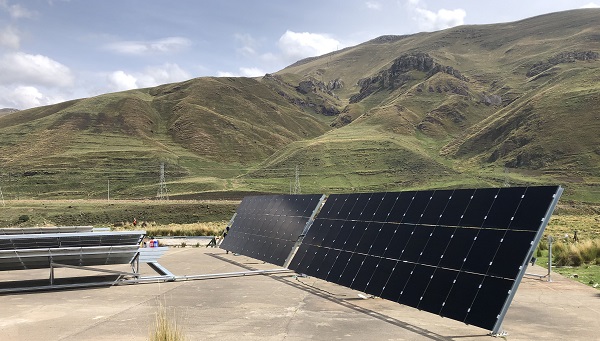New study analyses performance of four new solar technologies, testing which yields the best results in high-altitude environments. News Peru Solar power R&D
Peru is no exception to the sweeping climate pledges of nations planet-wide, having the potential of a significant increase in their use of renewable energy by 2050. To meet this commitment, the country will have to rely on a diverse mix of cleaner, greener power – which puts the spotlight on hydro, wind and solar to supply the bulk of it.
Peruvian mountains make for ideal high-altitude solar power test bed
The geography of Peru is a diverse mix of coastline, jungle and a striking swathe of snow-capped mountains that stretch the length of the country. The Peruvian Andes represent the largest concentration of high altitude (up to 6,000 metres) peaks in the Americas – peaks that could prove to be viable locations for solar installations.
High altitude based photovoltaic systems have proven to perform well in other parts of the world, particularly above 2,500 metres where there’s ample sunlight all winter long. Research shows that the cooler temperatures, reduced atmospheric pressure, and readily available, reasonably priced land well above sea level make for an ideal solar set-up. But these benefits are not without a few variables, such as strong winds, wildly fluctuating temperatures, and the passing storm or two that can severely impact panel performance.
Solar power is essential to Peru’s future power mix
For Peru’s renewable-powered future, it’s essential to test out new solar technology in high altitude conditions. Solar power will be a critical component of the country’s future energy mix, which means the mountains represent much needed real estate for mounting the radiation-absorptive panels. This was the initial premise for the Statkraft Peru team when they launched the country’s first-ever solar laboratory project in Junín, a town located the highlands of central Peru.
“In Peru, we don’t have this kind of solar technology at this altitude, which is why we’re interested in testing it. We have now built a solar installation at almost 4,000 metres above sea level for this project,” explains West Diaz, Head of Generation for Statkraft Peru.
15-person Statkraft team running SolarLab project through 2021
The project, called SolarLab, will serve as the training and testing centre for the Statkraft team, who will compare the efficiency and output of four different kinds of solar technology (thin film, monocrystalline, polycrystalline and bifacial) over the course of one year, throughout all seasons and all kinds of weather conditions.
“We will test the photovoltaic panels to see which performs best, no matter the snow, hail and wind that hits it. From there, we will analyse and share this data with the Research & Development team in Statkraft (Norway) and with universities and other interested parties. This kind of data on high altitude solar installations in Peru simply doesn’t exist yet, so many are eager to learn from our results,” says German Ortega, who is the project lead. https://player.vimeo.com/video/568884586?title=0&byline=0
Testing and eventually scaling solar is the goal for the Statkraft team
In addition to learning more about solar panel performance at high altitudes, Diaz says that the team will also benefit from the “know how” gained by installing, maintaining, and operating this type of technology. He calls it a great opportunity to practice for larger scale installations in the future.
He adds, “Our key challenge is to verify the best photovoltaic technology for capturing solar irradiation in the high elevations of Peru. This project is really about building our own expertise in this area, and most importantly, contributing to the energy development of our country, as we head towards a carbon neutral 2050.”
The Solar Lab construction in Junín was completed in January 2021, and the company is already six months into the test period. The testing site is located less than one kilometre away from the Malpaso Hydropower Plant, owned and operated by Statkraft Peru. By early 2022, Statkraft aims to possess the necessary data to evaluate larger solar installations at Malpaso and other sites.
“I hope by this time next year, we will have learned enough to scale this project, and have more solar power across Peru,” says Diaz. “That would be excellent.”


